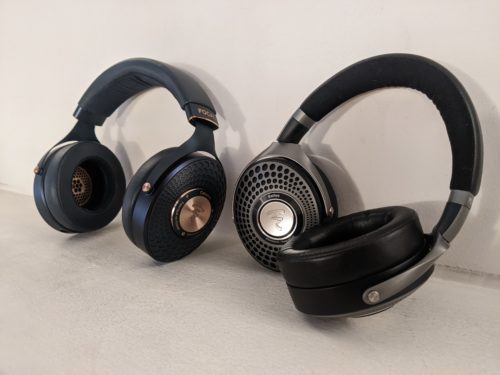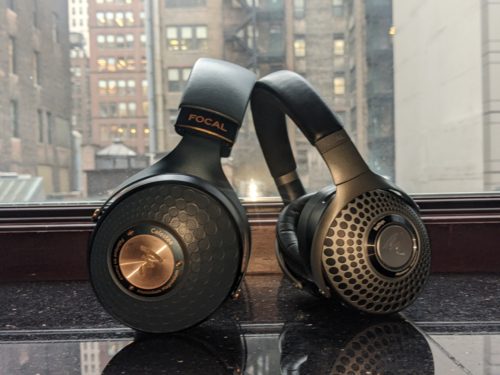Focal Bathys vs. Celestee Headphone Comparison Review
The murmurings and rumors stirring online about an October Focal release are finally vindicated. Hot off the heels of the Utopia 2022 release just a few weeks back, French audiophile company Focal has put out a new closed-back, wireless ANC model: the Focal Bathys. At $799, the Bathys sits at a similar price point as the popular Celestee ($999). It seems only fair that we put these two units head to head and see what’s similar, and perhaps more importantly, what’s different.

What’s In The Box?
Bathys
Focal Bathys ANC Wireless Headphones
Coaxial Headphone Cable with 3.5mm Jack
USBC Cable
Semi Firm carrying Case
Celestee
Focal Celestee Headphones
6.35mm Headphone Cable with 6.35mm Jack
Semi Firm Carrying Case
Look and Feel
Looks are arguably what the the Celestee and Bathys have most in common. Both have an asymmetrical, cellular like design on the the back of the cans and feature the Focal logo off-center. Don’t be fooled: looks are one of the few things these two headphones have in common.
The Celestee has a fit that Focal customers are probably pretty familiar with: a light headband pressure, with cans that I would describe as uniquely spring-loaded that strike an immediate balance on a listeners head when being worn. Isolation is fairly present though clearly not the Celestee’s M.O. The Bathys, on the other hand, has the distinct fit of a wireless over- ear. Maybe a little too much so. The fit took a little getting used to, as the Bathys chomped at my head with a determined headband pressure. Though this level of pressure is not something I’m generally used to, I have to say it was offset by the exquisitely comfortable ear pads, and also served its purpose of providing a great amount of isolation even with ANC mode turned off. I won’t get into it’s ANC and wireless specs too much here as the Celestee lacks such features and isn’t comparable in this regard, but you can read more about them in the Focal Bathys review here.
Specs
Celestee
-Driver: 40mm Aluminum Magnesium
-Frequency Response: 5Hz – 23kHz
-Sensitivity: 105 dB SPL / 1 mW @1kHz
Bathys
-Driver: 40mm Aluminum Magnesium
-Frequency Response: 15Hz – 22kHz
-Bluetooth 5.1
-Codecs: SBC, AAC, aptX, aptX adaptive

Sound Stage
Though I didn’t find the Bathys to have the deepest image, it made up for it with its vast width. I would describe the shape and style as left-right oriented and tubular. While I like a nice round sound image just like any other headphone nerd, the Bathys’ left-right handling really left me asking “Who cares?” Even if it’s not the most three dimensional, the staging was dramatic and accurate enough to provide an added intrigue to listens. Distance and spatial layering jumped to life on really hard pans, with some parts sounding physically closer to the side of my face than others.
The Celestee is similar so far as it’s primarily a left-right headphone, though just slightly lacking the Bathys’ ability to send parts flying across the stage. Though it provided a bit more depth than what I heard in the Bathys, it generally had a slightly smaller image; however, highs seemed to find favor in the imaging and occasionally stood out as exceptionally spatially layered.
There was an obvious common link in the staging and imaging, enough so that Celestee owners reading this review can rest assured that the Bathys is going to sound fairly familiar in this department. When it comes to EQ balance, however, there are some very significant differences to talk about.
Lows
The Celestee is an undeniably bright headphone that holds back on its subs, which are heard more than they’re felt and present naturally. “Crush” and “Jasmine” by Jai Paul should elicit a nice and thick vibration in the kick drum from any pair of headphones with satisfactory low end, and I’m happy to report that the Celestee was still able to rumble right along with those tracks. The Bathys is quite the opposite in its low end and seemed eager to pounce on bassier tones. Though the Bathys is somewhat evenly balanced in the context of ANC closed-backs, the emphasis is obviously in its bass response. The low character felt like is applied a smooth coating across the balance as a whole, all while avoiding overpowering the mix or creating unwanted masking. Tom-toms had a little extra physical rumble than what I usually experience and seemed to point to more emphasis on the higher end of the lows rather than the truly deep 20-40Hz range.
Mids
Though the mids as a whole remain fairly balanced, the Celestee is pretty eager to show you what its highs sound like and starts ramping up in the high mids. Snares have a trebly crack and are capable of ringing with rim harmonics. The full character of hi hats is brought pretty far forward in the mix and are elevated alongside the higher end of twangy clean guitar parts. Already trebly mixes, such as the album Four Calendar Cafe by Cocteau Twins, had a particularly fiery sound to them that I could foresee some listeners deeming harsh. Well…too bad for those listeners! I’m a very big fan of the Celestee’s mid-range treble and thought it added some glassy clarity to the driving parts of mixes such as guitars and vocals.
The Bathys isn’t the same risk taker that the Celestee is, retaining pretty natural low mids and scooping out a healthy portion of its upper mids. Acoustic guitars struggle to shine and often end up hiding away in their percussive transients (the Fleet Foxes album Shore seemed like it was the Bathys’ kryptonite). However, this is a common balance to come across in wireless ANC over ears, which seem to prioritize easy listening rather than taking a gamble on hashness. Though this handling of mids isn’t really for me, I can’t deny that it led to a very smooth balance. Vocals ended up sounding rich and smooth with their sibilants rounded out.
Highs
The Bathys partially compensates for its high mid cut by taking things back to normal in the highs – for a little while at least. Airiness and fry were fairly present in vocals, while acoustic guitars had an emphasis on their scratchy transients. The limits of the high end I will succinctly describe in terms of ride cymbals, which had a bit more ding than they did ring. Highs come through with enough clarity to avoid a muffled tone, but don’t quite accentuate the tippy-top, granular details of reverbs and cymbals.
The Celestee, on the other hand, is a dream for a treble head like myself. The boost in high mids keeps going well into the highs, giving a stunning level of details to cymbals and vocalist’s breaths. Sawtooth synths buzzed way up in their harmonic profile, and the shrill frequencies present in effects like clip distortion needled their way into listens with striking clarity. For people who are less sadistic about their high frequencies than I am, I have to admit that the Celestee poses the same harsh risks in its highs that are present in its high mids.
Overall
It’s a fool’s errand to say whether the Focal Celestee or Bathys is “better.” They are extremely different headphones that offer radically difference balances and are obviously suited for different uses. As for me? I like the Celestee a bit more for its courageous treble. But I guarantee that the people who aren’t so into its fiery tone will take comfort in the softer, more gentle Bathys. Focal can add the Bathys as another badge on its lapel right next to the similarly priced Celestee, offering a distinctly velvety yet well-defined and accurate warmth that I haven’t quite heard in another Focal product to date.
The Focal Bathys and Focal Celestee are both available for purchase at Audio46.
Compare the ranking of various headphones, earbuds and in-ear monitors using our tools.
Discuss this, and much more, over on our forum.
---MAJORHIFI may receive commissions from retail offers.













